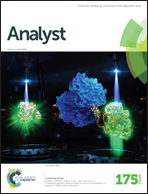New insights into the electrochemical detection application of p–p junction foam: the effects of the interfacial potential barrier†
Abstract
3D NiO/Co3O4 p–p junction foam was fabricated and applied for electrochemical detection of biomarkers. The theoretical model of employing the interfacial potential barrier as an electrochemical tuning factor was explored in depth. The signals of different targets with similar redox properties could be controllably distinguished by depressing or strengthening the potential barrier. The absorbed positively charged molecules would induce negative charges, inciting a decrease of the potential barrier height Φ and resistance, which is an enhanced tuning factor of the electrochemical signal. However, the effects of the absorbed negatively charged molecules went completely in the inverse direction; the resistance increased following by the increased Φ, which is a weakened tuning factor. Furthermore, the optimum adjustive effects of the p–p junction were validated as both the p-type regions are fully exposed. It is a general strategy to solve the difficulty in selective electrochemical detection of an analyte with similar redox properties. The results build a bridge to connect the potential barrier and electrochemical detection.


 Please wait while we load your content...
Please wait while we load your content...